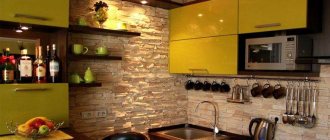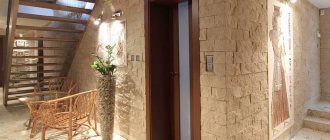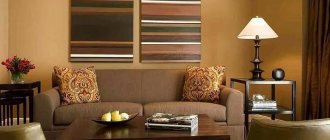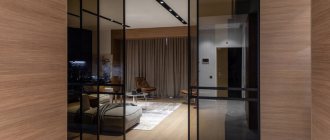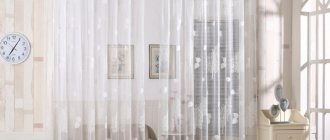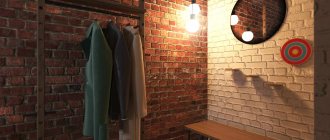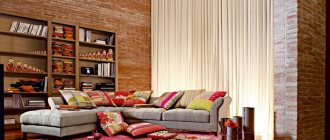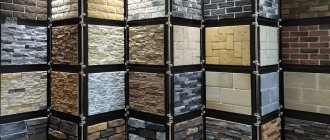You can use decorative stone in the kitchen interior in different ways: make a countertop, decorate the frying area, turning it into a hearth, or even lay out the entire kitchen backsplash. This will give the interior elements of primitiveness and at the same time a lot of grace. An undoubted advantage of decorative stone for the kitchen is its resistance to chemical, thermal and mechanical influences.
Photo: hausmobel.info
4. Decorative stone and lighting
A composition of stone and light can be an excellent interior decoration. The volume of the wall created by the stone, with the right lighting, can give your home the appearance of a small exhibition or a mysterious castle. With the help of light, you can highlight figurines, vases and other home decorations, which will look very advantageous.
Photo: usualhouse.com
Decorative stone and arches
Calculate the exact cost of repairs using an online calculator
and receive a free detailed estimate for repairs
Calculate
Decorating arches with decorative stone in an apartment as in the photo will bring a feeling of spaciousness and integrity to the room and emphasize the majesty of large rooms.
Photo: grassfire.org 6. Decorative stone at the front door
Decorating the front door with decorative stone will make your hallway look separate and attractive, as if in a photo from a magazine. A shelf with original things will add beauty and personality. The stone, in turn, will create a rich appearance. And pleasant dark colors will add a cozy atmosphere to the interior of your corridor.
Photo: fauxpanels.com
Decorative stone and tiles
Decorative stone can be presented in various shapes and colors. Quite an interesting solution - stone, finished as a tile that looks stylish, can fit beautifully into a minimalist interior, emphasize the clear contours of the room and give it volume.
Photo: squarespace.com
Styles
The hallway creates the first impression of the home, and therefore it is very important to choose its design. Let's consider design options that use the “stone + wallpaper” duo.
Modern style . Chooses white stone to match the brick and light wallpaper.
Eco style . Slate rocks are used here.
Urbanism . Uses brick-like tiles.
Classic . Decorates the walls with marble or granite.
Country and Provence . They use gray and brown stones of different shapes. Combined with regular wallpaper, photo wallpaper and murals.
It is not uncommon to add “street lamps” to such an interior.
Decorative stone and mosaic
An interesting solution is a small decorative stone in the interior of the living room. The photo shows one of these options. The varied colors and small size of the stones make it possible to create a very beautiful composition on the wall, which will become a prominent place in your home and will make both you and your guests delight.
Photo: clipgoo.com
Obvious advantages of the solution
Unlike natural stone, any imitation of it has every chance of fitting into the interior of an ordinary city apartment due to the increased practicality of the material and its technical characteristics. Moreover, in some cases, such a solution can give a solid head start to already well-proven finishing materials.
- low load on the walls
- most imitations are lightweight, so the elements can be fixed using ordinary tile adhesive or even liquid nails; - resistance to ultraviolet rays
- no fading of the texture even after prolonged exposure to the sun; chemical safety - the components do not contain any reagents hazardous to the human body, so you can decorate any room in your apartment with finishing stone for the walls, even the nursery; - resistance to mechanical stress
- of course, it is difficult to compare with natural stone in this indicator, but there is a good reserve; - simple installation
- practically no different from laying ordinary ceramic tiles, and in some cases it is even much easier - with gypsum stone, for example; - environmental friendliness
- even if the finishing stone imitates natural stone, it remains completely environmentally friendly due to the use of natural ingredients; - a wide choice of textures
is an obvious advantage of imitations, since you can choose absolutely any stone with a convincingly executed texture, and also subject it to post-processing, for example, paint or varnish; - affordable price tag for all options
- for many, it is the affordability of the price that will be the determining factor, and it’s hard to disagree with its attractiveness: natural stone costs an order of magnitude more.
Decorative stone and walls
Decorating the wall with decorative stone, as in the photo, will definitely attract your attention. Such a wall will focus on a certain part of the room, in which you can group other interesting interior details. This technique will enliven the atmosphere and create a cozy corner in your home.
Photo: thenhhouse.com
Decorative stone and sculptures
Decorative stone is a material that can be used in various shapes and colors, which gives us the opportunity to make an amazing thing out of it, such as a sculpture on the wall. Such works look very expensive and solid. It feels like you are in a museum.
Photo: myshindigs.com
Interior use options
If you have already decided what material you will use to imitate the stone texture, then it’s time to find a place for it in the interior. Where is finishing stone most often used inside an apartment?
Hallway
Always a winning solution, emphasizing the excellent taste of the owners. The slate rock looks great on the wall, favorably illuminated by spotlights: the desired volume is created, and if the stone is also varnished, you can get an excellent play with light.
Kitchen
Here it is best to use porcelain stoneware or flexible stone on the wall. The result will be equally beneficial, especially if you design the work area in this way. There are also frequent cases of using finishing stone to decorate a dining area. You can also use gypsum, but away from open sources of water and pre-treated with a primer.
Bedroom
In such an a priori calm and peaceful room, any stone texture on the wall fits without any problems. Refrain from dark rocks - they risk overloading the space and spoiling the atmosphere, but light slate, embanked dolomite or sandstone will add balance and organicity to the interior. By the way, you can choose an artificial stone in a neutral white color, and later paint it over with any suitable color.
Living room
A traditional place for active recreation for all family members. The use of finishing stone here allows you to emphasize the scale of the room and works great for the feeling of the overall nobility of the finish. There are frequent cases of similar design of walls in the area behind the TV.
or placed audio equipment - a winning option, especially highlighting the perimeter wall with an LED strip, and decorating the ceiling in an interesting floating version with a niche.
Bathroom and toilet
We have already noted that in rooms prone to high humidity, preference should be given to interior stone for walls that are not gypsum-based. There is an opinion that in such modest-sized rooms, the stone texture causes visual redundancy and spoils the interior. However, take a look at how it all looks in reality - and make sure that this is just an opinion, nothing more.
Decorative stone in the summer garden
Have you always wanted to create a garden in your apartment, but didn’t know how to do it? Our advice: using decorative stone. It can be used to create stunning and unusual shapes with a combination of stone and plants that will enliven your home.
Photo: diyhomedecor.co
Tips for caring for tiles
Gypsum coating can be maintained using dry and wet cleaning. It is permissible to use a vacuum cleaner with a special attachment, soft-bristled brushes, and damp rags. Abrasive materials and aggressive detergents can cause irreparable damage to the surface. The varnish coating significantly reduces the risk of damage to the top layer. To ensure the finish is resistant to moisture, it is treated with a special impregnation. After applying this product, the cladding can be washed.
Decorative stone and rest room
If you have a relaxation room in your home or are just planning to create one, think about beautiful decoration so that you can really enjoy relaxing in such a room. And decorative stone can perfectly cope with such a task. It will give the interior coziness, spontaneity and warmth.
Photo: sesa-build.com
Decorative stone in the bathroom
Bathroom surfaces finished with stone look majestic and reliable, in addition, they are protected from dampness and rapid wear and have antibacterial properties. Stone and water create the effect of being in nature, as if a waterfall is roaring somewhere nearby.
Photo: freshpalace.com
Preparing for finishing with artificial stone
Before starting finishing work, you need to calculate the materials. When covering an entire wall with stone, subtract the area of the openings and add an additional 10%.
For partial wall finishing, a drawing is created and each section is measured. Next, calculate the area by summing up all the indicators and add an additional 25% for pruning.
Advice! “When purchasing synthetic stone, it is important to consider that products of regular shape are measured in square meters, and free-form products are measured in linear meters.”
Required tools:
- Grinding machine or hacksaw;
- Level;
- File;
- Notched trowel for smoothing glue 15-17 mm;
- Spatula 7 - 9 cm;
- Construction line;
- Knife with replaceable blades for trimming wallpaper;
- Painting pencil for temporary markings;
- Varnish;
- Wide brushes;
- Primer.
Synthetic stone is attached to walls using special adhesive mixtures or gypsum mortar. The glue consumption is always indicated on the packages. Knowing the area of the area to be finished, it is advisable to take the composition with a small margin.
When measurements have been taken and materials and tools have been prepared, you can begin dismantling the old coating.
Removing old coating
If the project involves finishing the entire wall area with stone, the previous coating must be removed.
- Partial finishing will require some experience.
- On the wallpaper, mark the finishing lines with a paint pencil, taking into account a margin of 2 cm for the stones, and carefully trim them with a knife.
- Wallpaper is moistened with a solution to quickly remove old coatings and removed after 15 minutes.
The wall, cleared of old wallpaper, is washed. On walls painted with paint, remove peeling parts.
Forming a flat surface
At this stage, it is necessary to level the cleaned surface for greater durability of the coating. Potholes, cracks and dents are filled with putty.
In case of deep differences, it is advisable to plaster the treated area, especially for door frames, where significant cracks can form.
Padding
The dried surfaces must be sanded to smooth out the errors in the putty areas, and then cleaned with a brush to remove dust. Next, the surface is coated with an acrylic-based primer in two layers with a complete drying interval between them.
